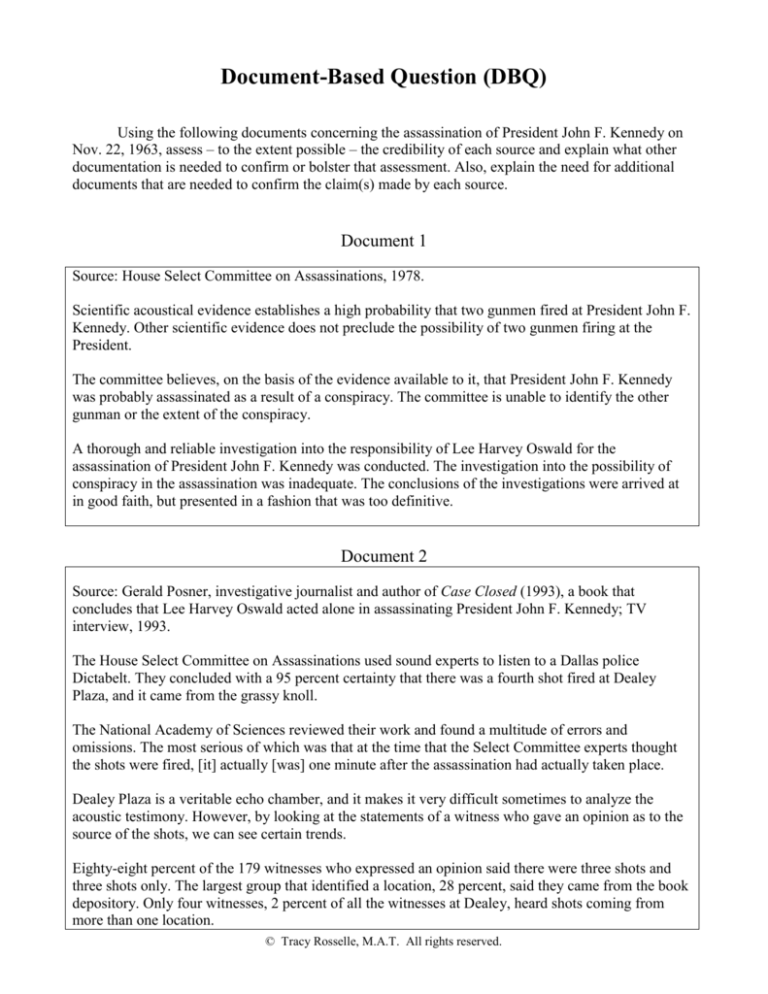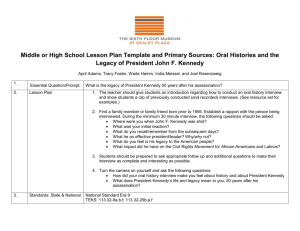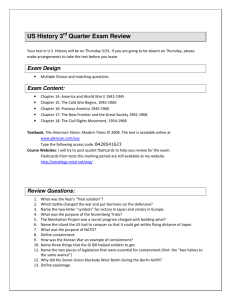
Document-Based Question (DBQ)
Using the following documents concerning the assassination of President John F. Kennedy on
Nov. 22, 1963, assess – to the extent possible – the credibility of each source and explain what other
documentation is needed to confirm or bolster that assessment. Also, explain the need for additional
documents that are needed to confirm the claim(s) made by each source.
Document 1
Source: House Select Committee on Assassinations, 1978.
Scientific acoustical evidence establishes a high probability that two gunmen fired at President John F.
Kennedy. Other scientific evidence does not preclude the possibility of two gunmen firing at the
President.
The committee believes, on the basis of the evidence available to it, that President John F. Kennedy
was probably assassinated as a result of a conspiracy. The committee is unable to identify the other
gunman or the extent of the conspiracy.
A thorough and reliable investigation into the responsibility of Lee Harvey Oswald for the
assassination of President John F. Kennedy was conducted. The investigation into the possibility of
conspiracy in the assassination was inadequate. The conclusions of the investigations were arrived at
in good faith, but presented in a fashion that was too definitive.
Document 2
Source: Gerald Posner, investigative journalist and author of Case Closed (1993), a book that
concludes that Lee Harvey Oswald acted alone in assassinating President John F. Kennedy; TV
interview, 1993.
The House Select Committee on Assassinations used sound experts to listen to a Dallas police
Dictabelt. They concluded with a 95 percent certainty that there was a fourth shot fired at Dealey
Plaza, and it came from the grassy knoll.
The National Academy of Sciences reviewed their work and found a multitude of errors and
omissions. The most serious of which was that at the time that the Select Committee experts thought
the shots were fired, [it] actually [was] one minute after the assassination had actually taken place.
Dealey Plaza is a veritable echo chamber, and it makes it very difficult sometimes to analyze the
acoustic testimony. However, by looking at the statements of a witness who gave an opinion as to the
source of the shots, we can see certain trends.
Eighty-eight percent of the 179 witnesses who expressed an opinion said there were three shots and
three shots only. The largest group that identified a location, 28 percent, said they came from the book
depository. Only four witnesses, 2 percent of all the witnesses at Dealey, heard shots coming from
more than one location.
© Tracy Rosselle, M.A.T. All rights reserved.
Document 3
Source: Mike Feinsilber, reporter for The Associated Press, story filed July 2, 1997.
Thirty-three years ago, Gerald R. Ford took pen in hand and changed - ever so slightly - the Warren
Commission's key sentence on the place where a bullet entered John F. Kennedy's body when he was
killed in Dallas.
The effect of Ford's change was to strengthen the commission's conclusion that a single bullet passed
through Kennedy and severely wounded Texas Gov. John Connally - a crucial element in its finding
that Lee Harvey Oswald was the sole gunman.
A small change, said Ford on Wednesday when it came to light, one intended to clarify meaning, not
alter history.
''My changes had nothing to do with a conspiracy theory,'' he said in a telephone interview from
Beaver Creek, Colo. ''My changes were only an attempt to be more precise.''
The Warren Commission concluded in 1964 that a single bullet - fired by a ''discontented'' Oswald passed through Kennedy's body and wounded his fellow motorcade passenger, Connally, and that a
second, fatal bullet, fired from the same place, tore through Kennedy's head.
The assassination of the president occurred Nov. 22, 1963, in Dallas; Oswald was arrested that day but
was shot and killed two days later as he was being transferred from the city jail to the county jail.
Conspiracy theorists reject the idea that a single bullet could have hit both Kennedy and Connally and
done such damage. Thus they argue that a second gunman must have been involved.
Ford's changes tend to support the single-bullet theory by making a specific point that the bullet
entered Kennedy's body ''at the back of his neck'' rather than in his uppermost back, as the commission
staff originally wrote.
© Tracy Rosselle, M.A.T. All rights reserved.
Document 4
Source: Photo of shirt worn by President John F. Kennedy on the day he was assassinated.
Document 5
Source: Jim DeEugenio, author of The Sins of Robert Blakey, a book about the House Select
Committee’s second chief counsel, G. Robert Blakey, published 1998.
Soon after he accepted the position, counsel Richard A. Sprague was introduced to photoanalystcomputer technician Richard E. Sprague. Sprague quickly arranged a presentation of the voluminous
photos that Richard E. Sprague had collected over the years, undoubtedly the largest collection of
pictures on the JFK case in any private collection. Sprague directed every hired detective and
researcher to attend a photographic slide show put together by the Kennedy researcher. According to
people who were there, it was a long and impressive presentation. But before the lights went down,
Sprague turned to everyone in attendance and said, "I don’t want anyone to leave unless I leave. And
I don’t plan on leaving." By the end of Sprague’s four-hour slide show, Al Lewis told me that, of the
13 staff lawyers in attendance, only one still held out for the single bullet theory.
© Tracy Rosselle, M.A.T. All rights reserved.
Document 6
Source: Louis Stokes, chairman of the House Select Committee on Assassinations, questioning of
reputed mob boss Santos Trifficante, 1978.
In 1967, 1971, 1976, and 1977, those four years, columnist Jack Anderson wrote about the CIAMafia plots and the possibility that Castro decided to kill President Kennedy in retaliation. Mr.
Anderson even contends in those articles that the same persons involved in the CIA-Mafia attempts
on Castro's life were recruited by Castro to kill President Kennedy. The September 7, 1976 issue of
The Washington Post contains one of Mr. Anderson's articles entitled, "Behind John F. Kennedy's
Murder," which fully explains Mr. Anderson's position. I ask, Mr. Chairman, that at this point this
article be marked as JFK exhibit F-409 and that it be entered into the record at this point.
Mr. Trafficante, I want to read to you just two portions of the article I have just referred to, after
which I will ask for your comment. According to Mr. Anderson and Mr. Whitten in this article, it
says: Before he died, Roselli hinted to associates that he knew who had arranged President
Kennedy's murder. It was the same conspirators, he suggested, whom he had recruited earlier to kill
Cuban Premier Fidel Castro. By Roselli's cryptic account, Castro learned the identity of the
underworld contacts in Havana who had been trying to knock him off. He believed, not altogether
without basis, that President Kennedy was behind the plot. Then over in another section, it says:
According to Roselli, Castro enlisted the same underworld elements whom he had caught plotting
against him. They supposedly were Cubans from the old Trafficante organization. Working with
Cuban intelligence, they allegedly lined up an ex-Marine sharpshooter, Lee Harvey Oswald, who
had been active in the pro-Castro movement. According to Roselli's version, Oswald may have shot
Kennedy or may have acted as a decoy while others ambushed him from closer range. When
Oswald was picked up, Roselli suggested the underworld conspirators feared he would crack and
disclose information that might lead to them. This almost certainly would have brought a massive
U.S. crackdown on the Mafia. So Jack Ruby was ordered to eliminate Oswald making it appear as
an act of reprisal against the President's killer. At least this is how Roselli explained the tragedy in
Dallas.
© Tracy Rosselle, M.A.T. All rights reserved.




